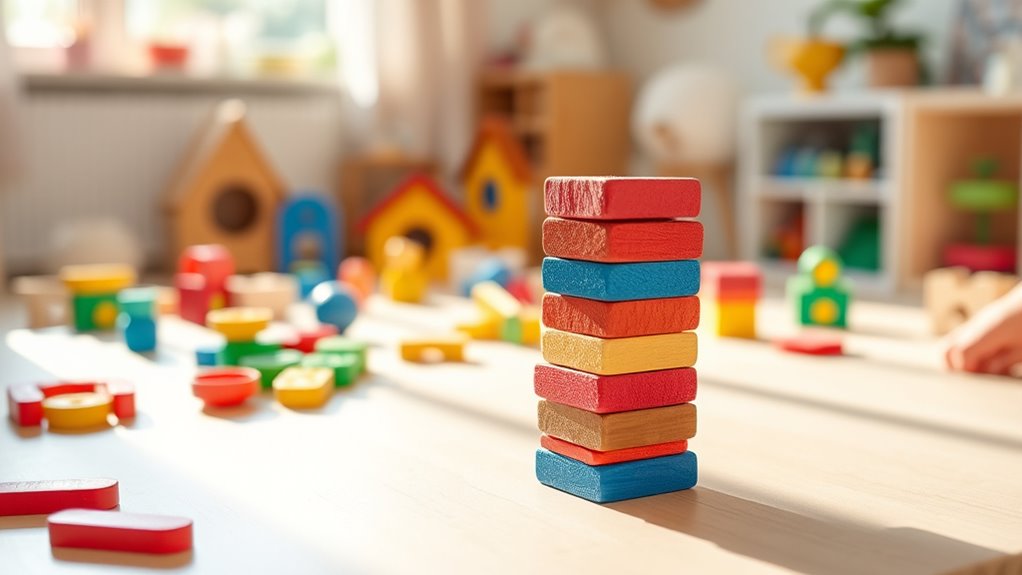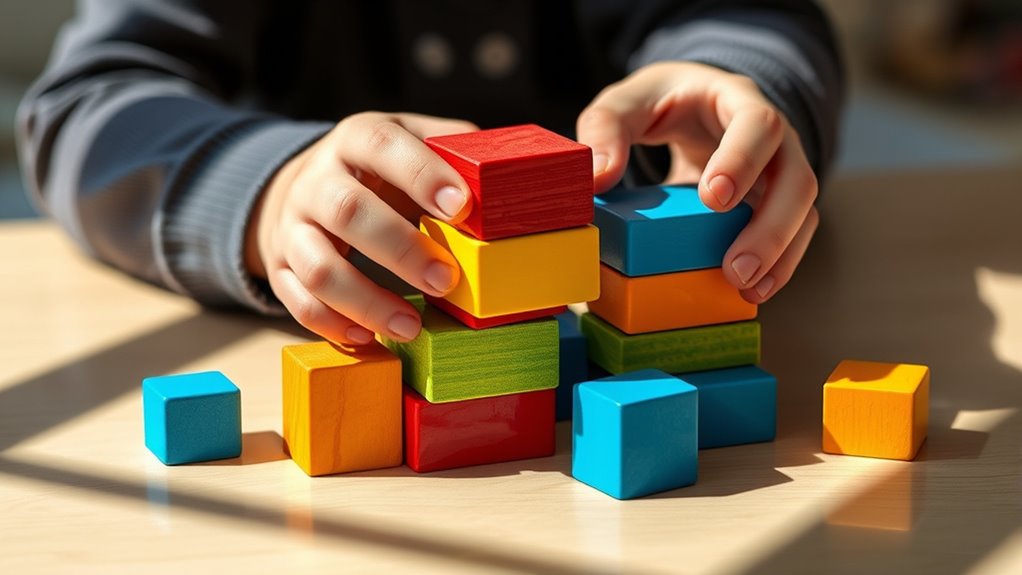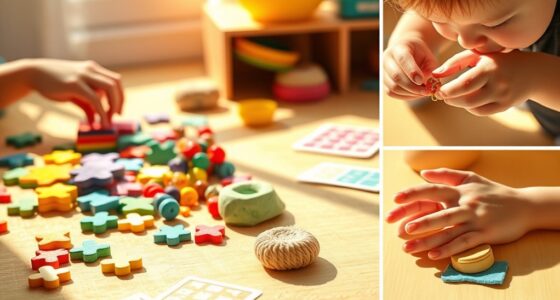Building block toys help your child develop critical brain skills by strengthening motor coordination, improving spatial reasoning, and encouraging problem-solving. As they stack, balance, and create, they enhance fine motor control and hand-eye coordination. Playing with blocks also fosters cognitive flexibility and critical thinking as your child experiments with different arrangements. Plus, building boosts confidence and independence. Keep exploring to discover more ways these toys support your child’s growth and learning.
Key Takeaways
- Stacking toys enhance fine motor skills and hand-eye coordination through precise block manipulation.
- They develop spatial reasoning by encouraging visualization and understanding of size, shape, and balance.
- Building with blocks promotes cognitive flexibility and problem-solving via trial-and-error and hypothesis testing.
- Playing with stacking toys boosts confidence, creativity, and self-awareness through personal achievement.
- Overall, they support foundational skills crucial for lifelong learning, including critical thinking and emotional resilience.

Have you ever wondered why building block toys have remained a favorite among children and parents alike? The answer lies in how these simple toys do so much more than entertain. When you give a child a set of blocks, you’re not just offering a fun activity—you’re providing a powerful tool for developing essential skills. As they grasp, stack, and balance the blocks, they’re strengthening their motor skills. Fine motor skills, which involve the small muscles in their hands and fingers, improve as they pick up and place the blocks precisely. Over time, this enhances their ability to perform everyday tasks like writing, drawing, or buttoning clothes.
But building blocks do more than just refine motor skills. They also serve as an excellent way to boost spatial reasoning—a critical cognitive skill that helps children understand how objects relate to each other in space. When children decide how to stack blocks to build towers or create patterns, they’re engaging their brains in visualizing and manipulating objects mentally. This process encourages them to think about size, shape, and position, which are foundational for math, geometry, and problem-solving skills later in life. As they experiment with different arrangements, they learn about balance, symmetry, and spatial relationships naturally, without formal lessons.
Playing with building blocks is inherently interactive, and that interaction is key to brain development. When you watch a child figure out how to fit different pieces together, you’re seeing their cognitive flexibility in action. They’re testing hypotheses: Will this block stay balanced here? Does this shape fit better in that spot? These trial-and-error experiences build resilience and critical thinking. Furthermore, as they work through these challenges, they’re developing persistence and concentration, skills that transfer into other learning areas. Additionally, engaging with these toys can support self-understanding by helping children recognize their preferences for different types of structures or patterns, fostering a sense of personal achievement.
Your role as a parent or caregiver can amplify these benefits. Encouraging your child to build and explore with blocks fosters creativity and self-confidence. You can introduce new challenges, like asking them to replicate a pattern or build a specific structure, which further stimulates their reasoning skills. The act of stacking and balancing also promotes hand-eye coordination, reinforcing their motor development. These small moments of play are, in fact, foundational building blocks for lifelong learning and problem-solving skills.
In essence, building block toys are more than simple playthings—they’re a gateway to vital developmental milestones. They engage your child’s motor skills and spatial reasoning in a natural, enjoyable way, setting the stage for academic success and everyday competence. So, next time your child picks up a block, remember: they’re not just playing—they’re building a brighter future.
Frequently Asked Questions
What Age Is Best for Introducing Stacking Toys?
You should introduce stacking toys around your child’s early milestones, usually between 6 to 12 months. At this age, they’re enthusiastic for sensory exploration and developing fine motor skills. Stacking toys help them improve hand-eye coordination and problem-solving while engaging their senses. Watching your little one experiment with different sizes and colors makes playtime both fun and educational, setting a strong foundation for future learning.
How Do Stacking Toys Support Social Skills Development?
Stacking toys can turn your little one into a social superstar! They promote emotional intelligence by teaching kids to share and take turns, making interactions smoother. When children engage in cooperative play with stacking toys, they learn essential social skills like patience and teamwork. These activities help your child understand others’ feelings and develop empathy, setting a strong foundation for healthy relationships as they grow.
Are There Any Safety Concerns With Stacking Toys?
You should always check for safety concerns with stacking toys, especially regarding toy durability and choking hazards. Make sure the toys are sturdy and made from non-toxic materials to prevent breakage. Avoid small parts that could pose choking risks, especially for younger children. Always supervise playtime, and regularly inspect toys for cracks or loose pieces. Choosing well-made, age-appropriate stacking toys helps guarantee your child’s safety during play.
Can Stacking Toys Help Children With Developmental Delays?
Did you know that children with developmental delays often show improved skills through simple activities? Stacking toys can substantially help by enhancing sensory integration and fine motor skills. You’ll notice better hand-eye coordination and increased confidence as they master stacking. These toys encourage exploration and problem-solving, making learning fun and effective. So, yes, stacking toys are a valuable tool to support children with developmental delays in their growth journey.
How Can Parents Incorporate Stacking Toys Into Daily Play?
You can incorporate stacking toys into daily play by setting aside dedicated times for creative play and sensory exploration. Encourage your child to experiment with different stacking techniques and colors, fostering their problem-solving skills. Use these moments to introduce new challenges and praise their efforts. By making stacking toys a regular part of your routine, you help develop their fine motor skills, creativity, and sensory awareness naturally and enjoyably.
Conclusion
By building with blocks, you boost brain development, bolster creativity, and foster fine motor skills. Stacking shapes stimulate spatial awareness while sparking your child’s supercharged problem-solving skills. So, seize the simple joy of stacking toys—supporting their steady, strong, and smart growth. Remember, every block you build shapes a brighter, bolder brain, making playtime not just fun but fundamentally fruitful. Embrace these building blocks—because a better brain begins with a single, supportive stack.










